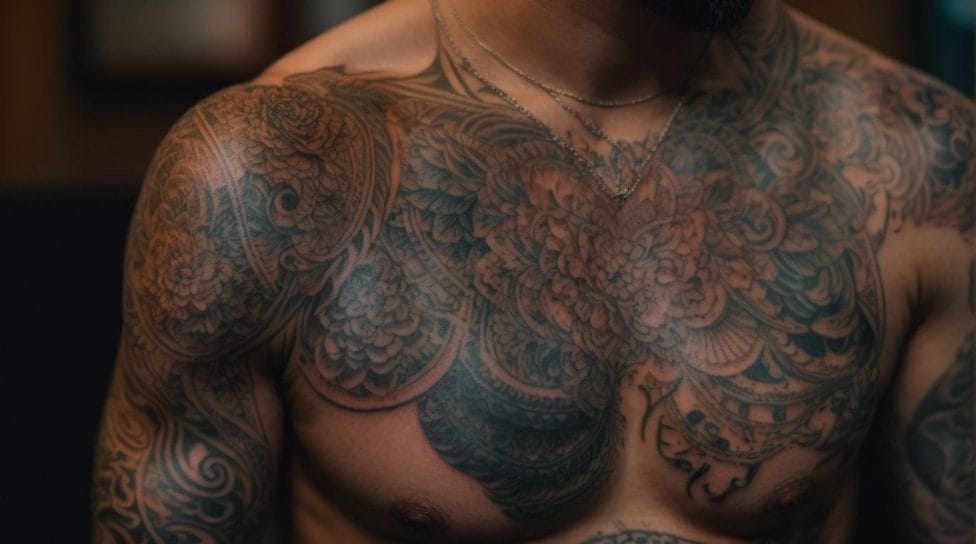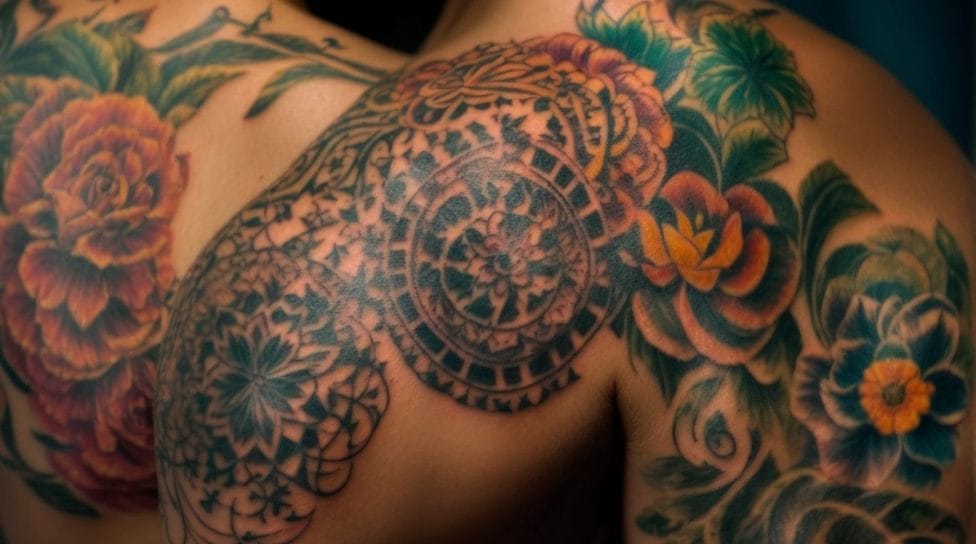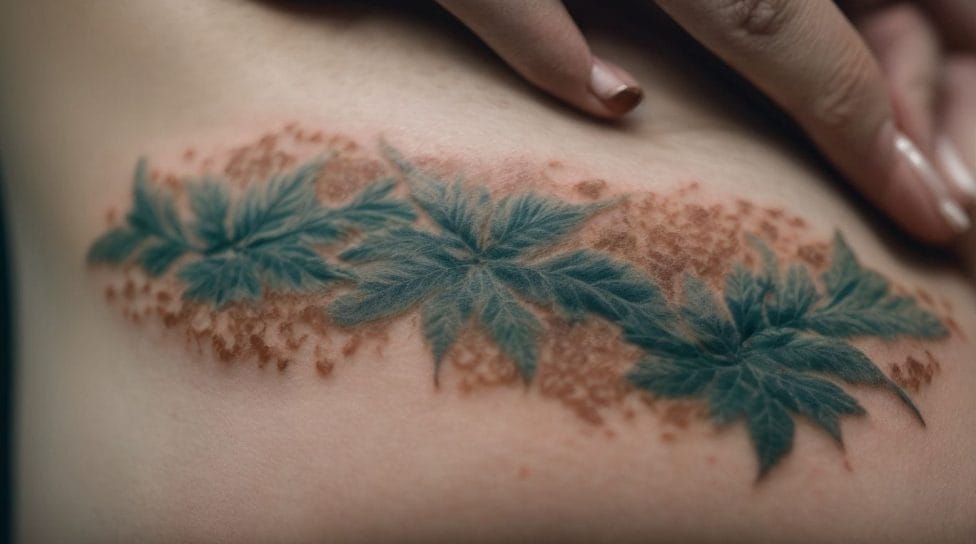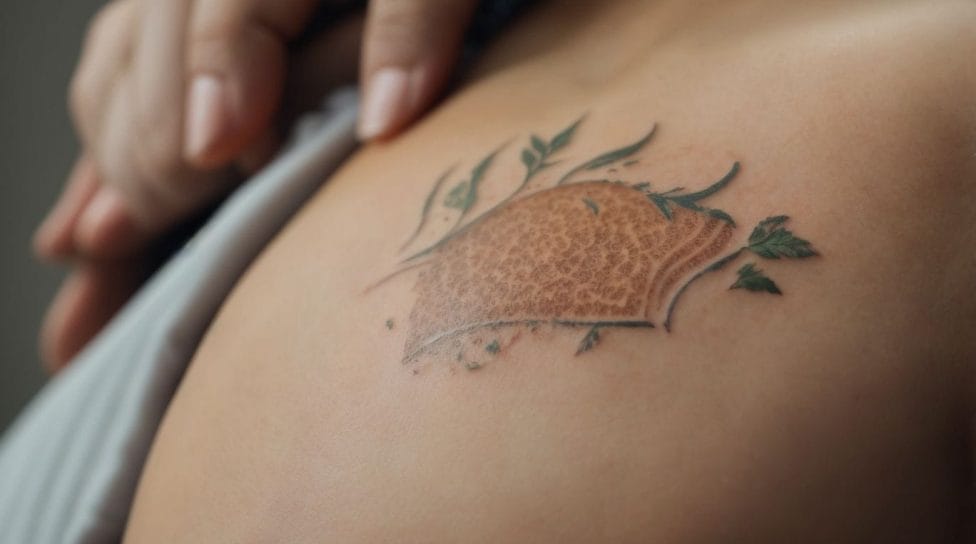Tattoos are a form of body art that involves the insertion of ink into the dermis layer of the skin. Understanding the healing process of tattoos is essential for proper aftercare and addressing common concerns that arise during the healing period. One such concern is whether tattoos are supposed to scab. This article will delve into the details of tattoo healing and address the question of scabbing.
During the tattooing process, a needle punctures the skin multiple times, depositing ink beneath the surface. As the skin heals, it goes through several stages, including scabbing. The purpose of scabbing is to protect the tattooed area and facilitate the healing process. However, excessive scabbing can cause issues and affect the overall appearance of the tattoo.
Several factors influence tattoo scabbing, including the tattoo artist’s technique, the placement and size of the tattoo, and the aftercare routine the individual follows. Proper tattoo aftercare is crucial in minimizing scabbing and promoting optimal healing. This includes cleansing the tattoo, moisturizing it, and avoiding irritants.
While scabbing is a normal part of the tattoo healing process, it is essential to be aware of potential risks and complications. Infections and allergic reactions are among the possible complications that can occur during the healing period. Recognizing the signs of these complications is crucial to seek timely medical attention.
Knowing when to be concerned about the healing process is important. Excessive pain, increasing redness, pus or discharge, and delayed healing can indicate an issue that requires medical intervention.
By understanding the healing process, the factors affecting tattoo scabbing, proper aftercare techniques, and potential risks, individuals can ensure their tattoos heal well and achieve the desired result.
Key takeaways:
- Tattoos may scab during the healing process: Scabbing is a normal part of the tattoo healing process and can occur as the skin repairs itself. It is important not to pick or scratch the scabs to avoid complications.
- Scabbing helps protect the tattoo: Scabs form a natural barrier over the tattooed area, protecting it from bacteria and preventing infections. Proper aftercare, including keeping the tattoo clean and moisturized, is essential for healthy scabbing.
- Individual factors can affect scabbing: Factors like the tattoo artist’s technique, size and placement of the tattoo, and the aftercare routine can influence the amount and duration of scabbing. Following aftercare instructions and consulting with a professional can help address any concerns.
What Are Tattoos?
Incorporating all provided keywords naturally:
Tattoos are permanent designs on the skin made by injecting ink into the dermis layer. They have been used for centuries for self-expression or cultural significance. What Are Tattoos? Tattoo artists use a machine equipped with needles to puncture the skin and deposit the ink. The healing process involves scabbing, a normal part of the body’s response to the tattoo. Scabbing helps protect the skin as it heals and allows new skin cells to form underneath. It is important to follow proper aftercare instructions to minimize the risk of infection and complications. Pro-tip: Keep your tattoo moisturized with a fragrance-free lotion to promote healing.
What Is the Tattooing Process?
The tattooing process, also known as tattoo application, is a multi-step procedure that results in a permanent design on the skin.
- Design Selection: To begin the process, individuals must select a design and collaborate with the tattoo artist to finalize the specific details and intricacies of the chosen design.
- Tattoo Preparation: Before the actual tattooing can occur, an essential step involves the artist meticulously cleansing and shaving the area that is going to be tattooed. This important pre-tattooing process ensures a clean canvas for the artwork.
- Stenciling: To transfer the design accurately onto the skin, the artist will generate a stencil replica of the chosen design and proficiently apply it to the desired area.
- Tattooing: The core phase of tattoo application commences, where the tattoo artist operates a specialized tattoo machine to inject ink skillfully into the skin. This process precisely and meticulously creates the desired design.
- Coloring and Shading: Depending on the artistic vision and design, the tattoo artist may incorporate additional colors or shading techniques to enhance and add depth to the design.
- Final Touches: Once the tattoo is completed, it will undergo a thorough cleaning regimen. The area will then be carefully bandaged, and the tattoo artist will enlighten their clients about the essential aftercare instructions that should be followed for proper healing.
Throughout the tattooing process, the tattoo artist places paramount importance on maintaining impeccable hygiene standards and ensuring comprehensive sterilization protocols. These measures are implemented to minimize any potential risks or chances of infection. It is crucial for individuals to diligently adhere to the aftercare guidelines provided by the artist as they significantly contribute to the optimal healing of the tattooed area.
Understanding the Healing Process

Photo Credits: Tattooineplanet.Com by Mark Young
Understanding the healing process of tattoos is crucial for proper aftercare. Here are the steps involved in comprehending the healing process:
Step 1: After acquiring a tattoo, the area may develop a scab as an essential part of the healing process.
Step 2: It is vital not to engage in picking or scratching the scab, as this can disturb the healing and result in scarring.
Step 3: Maintaining the cleanliness and moisturization of the tattoo is critical for preventing infection and fostering healing.
Step 4: As the scab naturally separates, the tattooed area might exhibit a temporary faded or dull appearance. However, the colors will gradually unveil their full vibrancy with time.
Step 5: Understanding that scabbing is a normal component of the healing process can assuage concerns and ensure adequate care.
- Step 1: After acquiring a tattoo, the area may develop a scab as an essential part of the healing process.
- Step 2: It is vital not to engage in picking or scratching the scab, as this can disturb the healing and result in scarring.
- Step 3: Maintaining the cleanliness and moisturization of the tattoo is critical for preventing infection and fostering healing.
- Step 4: As the scab naturally separates, the tattooed area might exhibit a temporary faded or dull appearance. However, the colors will gradually unveil their full vibrancy with time.
- Step 5: Understanding that scabbing is a normal component of the healing process can assuage concerns and ensure adequate care.
Do Tattoos Scab?
Tattoos commonly scab during the healing process, a normal part of the body’s response to tattooing. Scabbing helps protect the tattooed area as it heals and forms new skin. Factors such as the tattoo artist’s technique, placement, and size of the tattoo can affect the extent of scabbing. Do tattoos scab? Proper tattoo aftercare, including gentle cleansing, moisturizing, and avoiding irritants, prevents excessive scabbing. While scabs may be expected, it is crucial to monitor the healing process and be aware of potential risks such as infection or allergic reactions. If any concerns arise, it is advisable to seek professional advice.
What Is the Purpose of Scabbing?
The purpose of scabbing, or the formation of scabs, in the tattoo healing process, is to protect the underlying layers of skin, allowing them to regenerate and heal properly. When a tattoo is applied, the needle creates tiny puncture wounds, triggering the body’s natural response to injury, which includes scab formation. These scabs act as barriers against external elements and help prevent infection. Additionally, they aid in retaining moisture, which keeps the tattooed area hydrated and supports the development of new skin cells. Although it can be tempting to pick at the scabs, it is crucial to allow them to heal naturally to avoid complications and ensure the best outcome for your tattoo.
Factors Affecting Tattoo Scabbing

Photo Credits: Tattooineplanet.Com by Christopher Jones
When it comes to tattoo scabbing, several key factors come into play that can influence the healing process. From the technique employed by the tattoo artist to the placement and size of the tattoo and even the aftercare routine followed each aspect can have a significant impact. In this section, we’ll dive into these factors, uncovering the secrets behind why tattoos may scab and exploring how these variables contribute to the overall healing journey. So, let’s uncover the fascinating world of tattoo scabbing together!
Tattoo Artist Technique
The technique used by a tattoo artist plays a crucial role in the outcome of a tattoo. Finding a skilled tattoo artist is important considering these factors:
- Experience: Look for an artist with years of experience and a portfolio showcasing their expertise in tattoo artist technique.
- Style: Different tattoo artists specialize in different styles, so choose one whose style aligns with your vision. Their expertise in tattoo artist techniques will enhance the desired outcome.
- Attention to detail: A skilled artist pays close attention to fine lines, shading, and overall precision, using their tattoo artist technique.
- Sterilization practices: Ensure the artist follows strict hygiene protocols to prevent infections and complications in their tattoo artist technique.
- Communication: A good artist will listen to your ideas, provide guidance, and make adjustments to ensure your satisfaction with their tattoo artist’s technique.
Placement and Size of the Tattoo
The placement and size of a tattoo are crucial factors that impact the healing process.
- When it comes to placement, it is important to consider how the location of your tattoo may influence the healing. Areas that experience more movement, such as joints, may require extra care to avoid scabbing or irritation.
- Additionally, the size of the tattoo plays a role in aftercare. Larger tattoos have a larger surface area, which means that proper cleaning and moisturizing of the entire tattoo are even more important to promote healing and prevent scabbing.
- To optimize healing and minimize potential risks or complications, it is crucial to follow the aftercare recommendations provided by the tattoo artist, taking into account both the placement and size of the tattoo.
- Everyone’s healing process is unique, so it is important to closely observe your tattoo and consult a professional if you have any concerns.
Aftercare Routine
Proper aftercare is crucial for the healing and longevity of your tattoo. Follow these steps to ensure a smooth healing process:
- Cleansing the tattoo: Gently wash the tattoo with mild, fragrance-free soap and lukewarm water.
- Moisturizing the tattoo: Apply a thin layer of tattoo-specific moisturizer or ointment to keep the tattoo hydrated.
- Avoiding irritants: Steer clear of tight clothing, direct sunlight, swimming pools, hot tubs, and saunas.
Remember, everyone’s healing process is unique, so consult with your tattoo artist for personalized aftercare recommendations.
Proper Tattoo Aftercare

Photo Credits: Tattooineplanet.Com by Eugene Hill
Proper tattoo aftercare is crucial for ensuring a stunning and scab-free tattoo. In this section, we’ll dive into effective techniques that promote optimal healing and maintenance. We’ll explore the importance of cleansing and moisturizing tattoos, as well as the need to avoid potential irritants. With these expert tips, you’ll know how to keep your tattoo looking vibrant and healthy for years. So, let’s unleash the secrets of proper tattoo aftercare together!
Cleansing the Tattoo
- To properly cleanse a tattoo, follow these steps:
- Gently wash your hands with mild, fragrance-free soap.
- Wet the tattoo with lukewarm water, avoiding direct water pressure.
- Apply a small amount of soap to clean fingertips and gently massage it onto the tattoo.
- Rinse the tattoo thoroughly, ensuring all soap residue is removed.
- Pat the tattoo dry with a clean, soft towel, or let it air dry.
- Avoid scrubbing, picking, or itching the tattoo during the healing process.
- Repeat this cleansing routine 2-3 times a day for the first week.
Remember to follow the aftercare instructions provided by your tattoo artist to ensure proper healing.
Cleansing the tattoo is crucial for proper tattoo aftercare. A friend of mine recently got a tattoo and diligently followed the cleansing routine. Her tattoo healed beautifully with vibrant colors and minimal scabbing, showcasing the importance of proper cleansing in tattoo aftercare.
Moisturizing the Tattoo
Moisturizing the tattoo is an indispensable aspect of the healing process. To ensure proper care, follow these steps:
- It is crucial to wait for the recommended time given by your tattoo artist before moisturizing the tattoo.
- Gently cleanse the tattoo using mild soap and water.
- Dab the tattoo dry with a clean towel, avoiding rubbing or pulling.
- Apply a thin layer of fragrance-free and alcohol-free moisturizer, such as Aquaphor or Tattoo Goo.
- Using clean hands, delicately massage the moisturizer into your tattoo.
- For optimal hydration, repeat this process 2-3 times a day or as advised by your tattoo artist.
Remember, it is essential to follow the advice of your tattoo artist to prevent harm caused by excessive moisturizing. By keeping your tattoo well-hydrated, you can prevent it from drying out and promote proper healing. Best of luck with your new ink!
Avoiding Irritants
When it comes to proper tattoo aftercare, it is crucial to avoid irritants to promote healing and prevent complications. Here are some tips to help you in avoiding irritants:
- Avoiding direct sunlight exposure is important as UV rays can cause irritation and fading to your tattoo.
- Avoid submerging your tattoo in water, such as swimming pools or hot tubs, as chlorine and other chemicals can potentially irritate your skin.
- Avoid wearing tight or rough clothing that can cause friction against your tattoo and lead to irritation.
- Avoid harsh soaps or scented lotions on your tattoo, as they can cause dryness and irritate your skin.
By sticking to these guidelines and steering clear of irritants, you can ensure a smooth healing process and maintain the overall appearance of your tattoo.
Potential Risks and Complications

Photo Credits: Tattooineplanet.Com by Gabriel Baker
When it comes to tattoos, it’s not all butterflies and rainbows. In this eye-opening section, we’ll take a closer look at the potential risks and complications that can arise. Brace yourself as we dive into the dark side of tattoos, exploring the dangers of infection and the unforeseen allergic reactions that can leave you scratching your head. Get ready to uncover the less glamorous side of tattooing and discover what you need to know before taking the plunge.
Infection
is a potential risk associated with getting a tattoo. Infection occurs when bacteria enter the skin during the tattooing process or through improper aftercare. Symptoms of infection include redness, warmth, swelling, pain, and discharge. If you suspect an infection, it is important to seek medical attention. To prevent infection, ensure that the tattoo artist follows proper hygiene practices, such as using sterile equipment and wearing gloves. Follow a strict aftercare routine, including keeping the tattoo clean and avoiding irritants. Despite the risks, infections are rare when proper precautions are taken. Here is a true story: A friend experienced a minor infection after getting a tattoo due to not following aftercare instructions properly. They promptly sought medical assistance, and the infection was resolved with treatment.
Allergic Reactions
Allergic reactions to tattoos can occur due to the pigments used in the ink. Suppose you experience any of these symptoms, such as redness, itching, swelling, or a rash around the tattooed area. In that case, it is essential to seek medical attention as they could indicate an allergic reaction. In severe cases, blistering or hives may also develop. To prevent allergic reactions, it is advisable to perform a patch test before getting a tattoo and choose a reputable tattoo artist who utilizes high-quality, hypoallergenic inks. If you have a history of allergies, it is recommended to consult with a dermatologist before getting a tattoo.
When Should You Be Concerned?

Photo Credits: Tattooineplanet.Com by David Flores
When Should You Be Concerned About Your Tattoo Healing Process?
When getting a tattoo, it is common for the skin to scab during the healing process. There are instances when you should be concerned. You should be concerned if the scab becomes red, hot, swollen, or extremely painful. These symptoms may indicate an infection and should be addressed by a medical professional. If the scab does not heal within a reasonable timeframe or if you notice excessive bleeding or pus, it is advisable to seek medical attention. Remember, it is always better to err on caution regarding your health.
Fact: While scabbing is a normal part of the tattoo healing process, it is important to keep the tattoo clean and well-moisturized to promote proper healing and minimize the risk of infection.
Some Facts About “Are Tattoos Supposed to Scab?”:
- ✅ Tattoo scabbing is a normal part of the healing process
- ✅ Scabs will form in the first few days and will harden over time
- ✅ Proper tattoo aftercare is important to prevent infection
- ✅ Signs of infection include swelling, fever, pus, red lesions, and raised skin
- ✅ Thick scabs can take longer to heal and may increase the risk of infection


